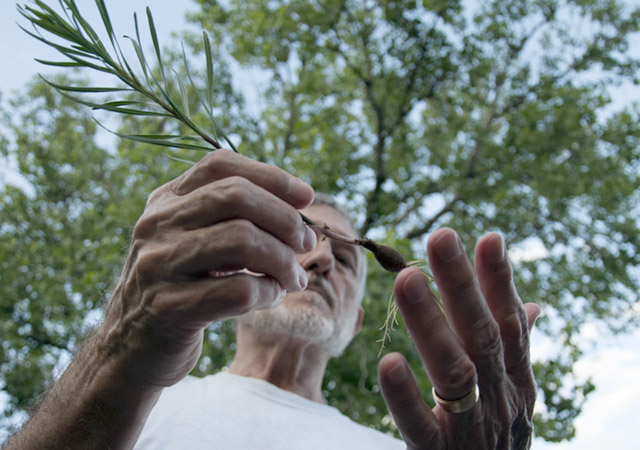Champion of Wildlife Spreads the Gospel of Backyard Habitats

Dale Bulla’s Jester Estates yard has hundreds of native plants, part of his efforts to make his property a haven for wildlife of all kinds. He’s holding a liatris plant, also known as gayfeather, which provides food for monarch butterflies. Photo by Fernanda Del Toro/Reporting Texas
By Darby Kendall
For Reporting Texas
A backyard where feral hogs feel free to visit might not appeal to most homeowners. But Dale and Pat Bulla welcome wildlife of all kinds into their Northwest Austin yard.
In 2001, the Bullas were the first in their neighborhood to have their property certified as a backyard wildlife habitat by the National Wildlife Federation. They didn’t stop there. Dale has cajoled, persuaded and gently arm-twisted more than 200 of his Jester Estates neighbors to do the same. Now the 900-home subdivision, sandwiched between FM 2222 and Capital of Texas Highway, accounts for nearly 10 percent of the 2,154 certified habitats in Austin, most of them residential backyards.
Dale Bulla roams his neighborhood, looking for more candidates. “If I see a yard that has that potential, I will stop and ask if they might be interested,” he said. “Every month, I put a picture of a certified habitat yard in our neighborhood newsletter along with my contact information to encourage folks.”
To become certified, homeowners must provide food, water, cover from predators and a place where wildlife can raise their young, such as birdhouses. They must use native plants and avoid using pesticides or herbicides. The federation created the program to counter the rapid decrease in wildlife habitat because of development.
The Bullas pulled out all the stops with their own half-acre lot after moving to Austin from Dallas in 1998. Their house is set into a hill, surrounded by trees, boulders and hundreds of native plants, dozens of them labeled with metal signs. There are solar panels on the roof and a rainwater harvesting system. The Bullas make their own compost.
“When we built the house, we didn’t let a bulldozer on the property, so that saved a lot of native plants; we left it all natural,” said Dale Bulla, a retired teacher and former professional storyteller.
The Bullas’ inaugural community project was helping their church, the First Unitarian Universalist Church of Austin, become the first place of worship to be a certified habitat in Texas in 2001. Then they moved on to their neighbors.
Amanda Rolls said Dale approached her in 2011 about getting her yard certified. Rolls said she didn’t mind, because he was just so enthusiastic. “Dale’s a good spokesperson,” Rolls said. The program “just seemed like a good thing to advertise… It seems to me that people do it because its beneficial.”
While Rolls’ yard is not quite as singular as the Bullas’, it still attracts wildlife such as armadillos, deer, various lizards and pollinators including bees and butterflies.
In March, the federation named Austin the top city for wildlife, citing its concentration of certified habitats — more than any other U.S. city — as well as other local initiatives to protect wildlife. “People in Austin recognize that wildlife is important to our ecosystem, which is why we have so many habitats,” said Meredith Gray, the conservation program coordinator for Wildlife Austin, an Austin Parks and Recreation initiative that partners with the federation. “It’s southern hospitality for wildlife.”
The Bullas’ own property is nothing if not wildlife friendly.
“We have over 200 native plant species in our yard,” Dale said, including bluebonnets, red yucca, big-tooth maples and coral honeysuckle. They’ve made sure to have plants that bloom at different times so there’s always something for birds and bees to snack on.
“We’ve seen cardinals, woodpeckers, painted buntings and lots of butterflies. It doesn’t need much maintenance. Lots of the birds take care of the pests,” he said. The couple also has seen skinks and other lizards, screech owls, titmice and toads, Pat Bulla said.
The Bullas’ land backs up to the Balcones Canyonlands Preserve, a refuge for migratory birds. Although the location assures plenty of bird sightings, there is the downside of the feral hog visits. According to Dale, the hogs tear up their landscaping and trails, leaving the couple to make repairs.
The hog damage recently has gotten worse, Dale Bulla said. “This year has been the biggest problem, mainly because many of our neighbors have put up fences and forced the hogs into new areas.” But the Bullas accept the hogs along with more appealing wildlife.
Dale Bulla said he’s not done yet with spreading the native habitat gospel. “We still don’t have all of our libraries, police departments and fire stations certified,” he said, “so we have more to do.”